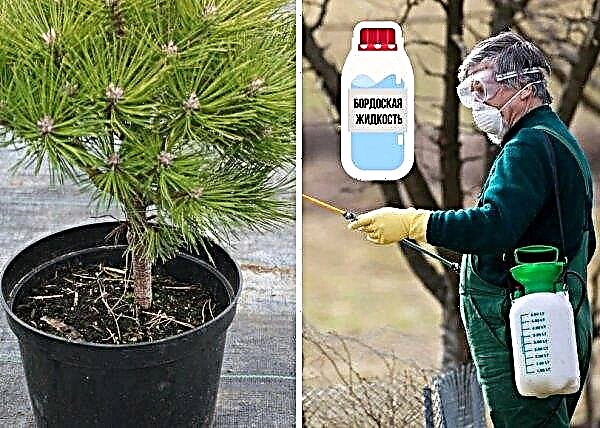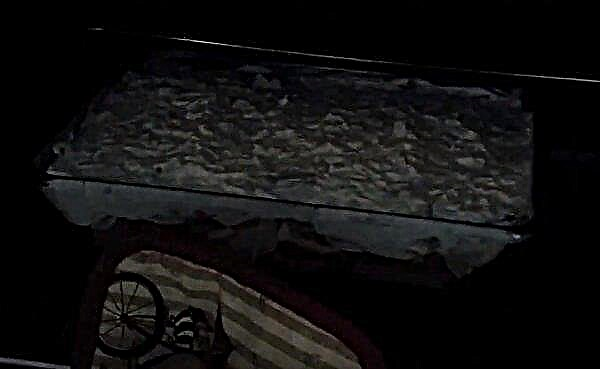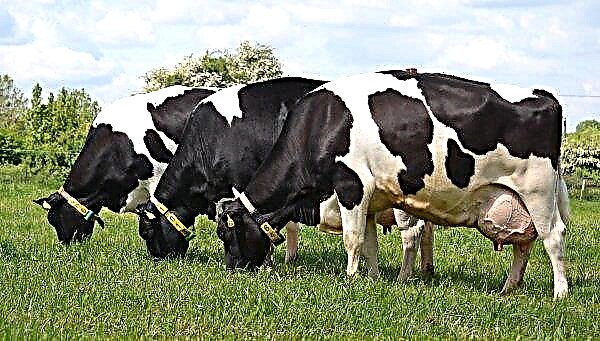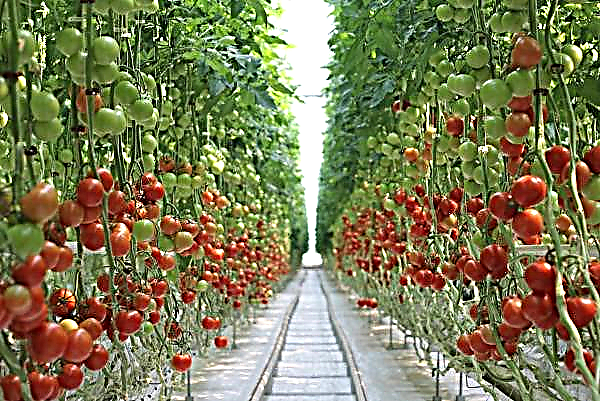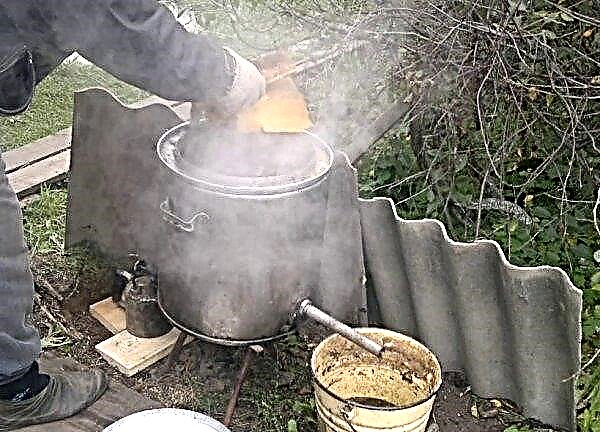Each beekeeper sooner or later faces the need to reproduce bees, but not everyone knows how to properly carry out this procedure. From this article you will learn about the forms of artificial propagation of honey insects, the intricacies of each method, as well as what equipment you need to use for this.
Forms of artificial propagation of bees
In the natural environment, bees reproduce by swarming, but this is not recommended in the apiary, since the process of tracking and catching a swarm takes a lot of time. For this reason, beekeepers use in practice an artificial method of breeding bees.
Layering
Families should be increased at the end of the season after the end of the main honey collection, the optimal time for this is from the beginning to mid-August.
Video: how to make a bee family layering
For layering, you must adhere to the following instructions:
- To collect a new beehive, in which it is necessary to place a heater, a choke, on two sides 2 covering frames with honey. Behind the covering frames, put the old land.
- Move to the hive with a bee family, which will be used for breeding.
- Find the queen bee by looking through the frames one by one.
- Having found the uterus, carefully get it out and put the frame back into the hive.

- Eliminate the uterus.
- Take brood with insects and put in a box.
- In the old hive leave cover frames and divide the remaining frames into 2 families. Transfer about 4 to the second family.
- In the family from which the framework is removed, it is imperative to insert sushi.

- It is imperative to place a feeder with sugar syrup near the hives.
- In a new prepared hive, carefully place the frames with bees and brood, and cover it.
- Give both bee families time to feel that they were left without a queen. After 2 hours, substitute the uterus in the family.

Uterine
To make layering on a mature mother, you should carry out such actions:
- Take an empty hive and place a honey-perg frame there.
- Carefully take the frame with the queen cell, trying not to hook the uterus, and put it in the hive.
- Next, place 2 frames with printed brood in the hive.
- Put 2-3 frames of land in the hive so that the uterus has where to sow.
- In layers you need to shake off 1-2 frames with young bee individuals.
- Close the hive.
Important! You do not need to make large and strong lay-offs on the mother, because if the uterus does not fly around, the bees will fly away and the family will disappear.
Video: layering on a mature mother
Division
In this way, strong bee colonies, as well as medium-strength families, are halved.
For its implementation in a multihull hive, the following instructions should be used:
- Open the hive, remove the upper case and put it on a new bottom.
- Move the hives slightly so that the flying bees are divided into 2 hives.
- Find the frame with the uterus and put it in a specially prepared place for this.
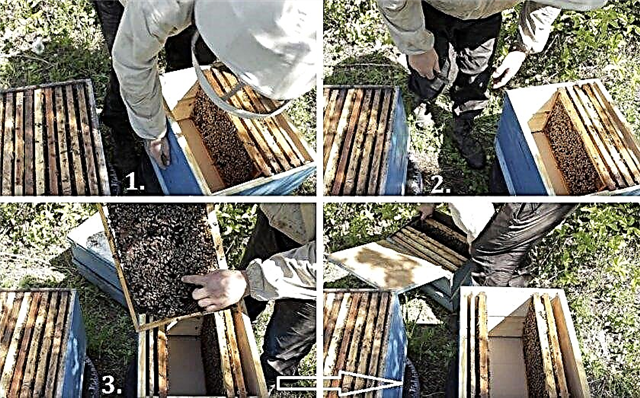
- Leave honey frames around the edges, place the brood in the middle.
- Move several brood frames from the first hive to the second so that their number is the same.
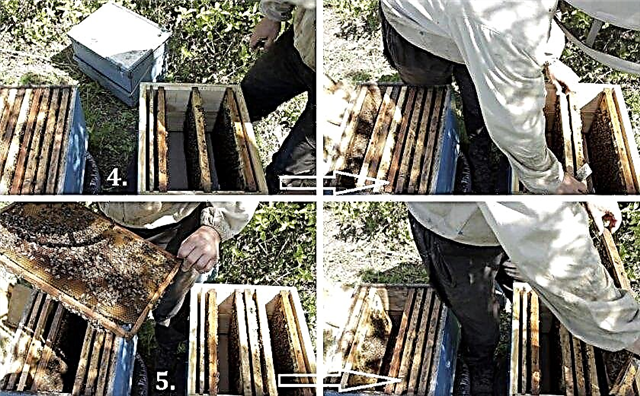
- In the first beehive, place a frame with the uterus, as well as a honey pen.
- Close the hives with a lid.
- To mark a hive in which there is no uterus, - the next day you need to place the mother liquor there.
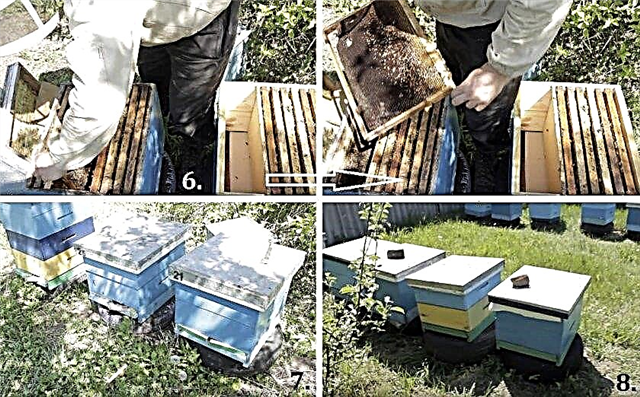
Rotation system
The cultivation of honey insects in the rotational system is an effective way to prevent various diseases.
Did you know? Bees from one hive per year are capable of storing up to 150 kg of honey.
To propagate so a bee family, you must:
- View the swarm state of the hives, for which purpose do the inclination of the second housing of the nest.
- Remove the sealed drone brood of the working frame.
- After viewing, open the case for honey and check the honeycomb.
- Add a second body for honey, before installing which you need to remove all wax bridges from the upper bars of the frames.
- Install honeycombs on the second honey case.
- From the first spring bribe, the bee family should be delivered to the mother apiary to form artificial swarms.
- Take a bag, funnel, scales and sprayer with water.
- Determine the packaging for layering.
- For removable frames with honey from the hull, take the bottom, hull and roof of the hive for transportation.
- Install a funnel and irrigate it with water to prevent insects from leaving the bag.
- Slightly tilt the second housing of the nest and fumigate so that the new bees move into the housing with honey.
- Remove both cases with honey to prevent the return of young bees to the nest.
- Close the hive to prevent theft.
- Excess bees and honey removed from the hive.
- Fill the bees in a bag through the funnel until the desired amount in the layer is reached.
- Put the bag on the scale. An artificially created swarm should weigh about 1250 g.
- Close the bag with a lid and put the box in the shade; upon completion of work in the apiary, take the bags with you.
- After returning from the apiary, unload packages with bees.
- Treat packages with a remedy to combat varroatosis.
- Launch the uterus in the cell, having previously cut one wing to one third.
- Secure the cage with the uterus with wire on the hook of the box.
- Within 24 hours, packs with artificial swarms put on white paper in a cool room.
- Put honey and sugar dough on each bee bag.
- After 24 hours, remove food residues from the bag.
- During the rest day, the bees create new families, which will later be placed in hives.

What is necessary for breeding bees
Getting to the breeding of bees, you need to find out the features of this procedure, select the necessary equipment, as well as conduct the correct preparatory measures.
Did you know? Under favorable conditions, the queen bee can lay up to 1000 eggs daily.
Features
When breeding bees at home, the first thing to do is:
- The right place for the apiary. It should be in the area where the trees grow, sheltered from the wind.
- Placing beehives with a slope to the south, so that they are in the sun.
- Obligatory fence of the apiary with a fence about 2 meters high.
- The hives should be located away from the routes of people and as far as possible from the roads.
- An apiary should not be placed in a damp place and close to plants, as this can cause illness and death of insects.

Inventory
For the breeding of bees, the beekeeper will need such a mandatory inventory:
- Overalls. Includes a jumpsuit and a mask to protect against bee stings.
- Smoker. Serves to pacify insects and comfort the beekeeper when working with a bee family.
- Swarm. It is necessary for replanting a swarm and storing it in a shaded place until transplanting into a hive.
- Brush. Used to sweep away bees from frames or litter from the bottom of the hive.
- Chisel. It is necessary in order to push the frames, as well as clean them and the inner walls of the hive.

Breeding preparation
In order to prepare for the cultivation of honey insects, it is necessary to ensure the availability of a stock of queens to replace old, painful or dead individuals. In addition, since the uterus is the only female in the family with a developed reproductive system, it is necessary for the bees to multiply and expand the apiary.
Independent breeding of breeding queens is not an easy task. For this, special families should be formed in which the uterus will be excreted. Suitable time for breeding these individuals is the end of spring and the beginning of summer, during this period insects will grow stronger after wintering, and honey plants will be in the active flowering phase.
Important! After receiving the uterus after transportation, you must immediately place it in the hive, since prolonged maintenance in the cell can adversely affect its productivity.
The most healthy and high-quality queens can be bought at specialized farms. In this case, special cells are used to transport these insects, where, in addition to the uterus, several accompanying bees and honey for feeding are placed.
Reproduction of bees is one of the important factors of beekeeping. By choosing the appropriate method for yourself and observing in practice all the instructions, you can achieve an increase in the number of bee families in your apiary.







